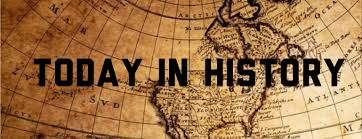September 18 1793: Capitol cornerstone was laid
On this day in 1793, George Washington laid the cornerstone to the United States Capitol building, the home of the legislative branch of American government. The building took nearly a century to complete, as architects came and went, the British set fire to it and it was called into use during the Civil War. Today, the Capitol building, with its famous cast-iron dome and important collection of American art, is part of the Capitol Complex, which includes six Congressional office buildings and three Library of Congress buildings, all developed in the 19th and 20th centuries.
On this day in 1793, George Washington laid the cornerstone to the United States Capitol building, the home of the legislative branch of American government. The building took nearly a century to complete, as architects came and went, the British set fire to it and it was called into use during the Civil War. Today, the Capitol building, with its famous cast-iron dome and important collection of American art, is part of the Capitol Complex, which includes six Congressional office buildings and three Library of Congress buildings, all developed in the 19th and 20th centuries.
As a young nation, the United States had no permanent capital, and Congress met in eight different cities, including Baltimore, New York and Philadelphia, before 1791. In 1790, Congress passed the Residence Act, which gave President Washington the power to select a permanent home for the federal government. The following year, he chose what would become the District of Columbia from land provided by Maryland. Washington picked three commissioners to oversee the capital city’s development and they in turn chose French engineer Pierre Charles L’Enfant to come up with the design. However, L’Enfant clashed with the commissioners and was fired in 1792. A design competition was then held, with a Scotsman named William Thornton submitting the winning entry for the Capitol building. In September 1793, Washington laid the Capitol’s cornerstone and the lengthy construction process, which would involve a line of project managers and architects, got under way.
In 1800, Congress moved into the Capitol’s north wing. In 1807, the House of Representatives moved into the building’s south wing, which was finished in 1811. During the War of 1812, the British invaded Washington, D.C., and set fire to the Capitol on August 24, 1814. A rainstorm saved the building from total destruction. Congress met in nearby temporary quarters from 1815 to 1819. In the early 1850s, work began to expand the Capitol to accommodate the growing number of Congressmen. In 1861, construction was temporarily halted while the Capitol was used by Union troops as a hospital and barracks. Following the war, expansions and modern upgrades to the building continued into the next century.
Today, the Capitol, which is visited by 3 million to 5 million people each year, has 540 rooms and covers a ground area of about four acres.
September 18 1972
A small army of Ugandan exiles crossed the border from Tanzania, but was easily repulsed.
September 18 1972
President Muammar Muhammad Gaddafi, Libya, and President Muhammad Ahmad Anwar Sadat, Egypt, agreed to a joint capital: Cairo.
September 18 1981: Canada mall sets parking-lot record
On this day, the 20,000-car parking lot at Canada’s West Edmonton Mall makes the Guinness Book of World Records as the largest parking lot in the world. The mall has held other records, too: At one time or another it’s been the World’s Largest Shopping Mall (5.2 million square feet, or about 48 city blocks), the World’s Largest Indoor Amusement Park and the World’s Largest Indoor Water Park (which includes the World’s Largest Indoor Lake and the World’s Largest Indoor Wave Pool).
The West Edmonton Mall has more than 800 stores, 100 restaurants, and 19 movie theaters. It also has a full-size ice-skating rink, where the Edmonton Oilers occasionally practice; two hotels, one of which boasts elaborately themed rooms (the Hollywood Room, the Polynesian Room, the Igloo Room, the Canadian Rail Room, the African Room, and the Arabian Room, for example); a chapel; and a sizeable handful of nightclubs. The mall is arranged in a series of wings, also themed: There is an opulent 19th-century European boulevard, a faux Bourbon Street, and a Chinatown wing arranged around a koi pond. A replica of Christopher Columbus’ famous Santa Maria shares a lagoon with real submarines and exotic fish. When the mall opened in 1981, its developer offered this dedication: “What we have done means you don’t have to go to New York or Paris or Disneyland or Hawaii,” he said. “We have it all here for you in one place, in Edmonton, Alberta, Canada!”
Though the mall has held the world’s largest parking-lot record for years, some people argue that it shouldn’t: Because the lot is half indoors and half outdoors, they say, it’s actually not one parking structure but two. By that calculation, you can find the world’s largest parking lot at Seattle’s Sea-Tac airport, which has 13,000 parking spaces under one roof. At any rate, huge lots seem to be everywhere: Universal Studios has two 10,000-car garages, the Denver airport has two 7,000-car lots, and the Baltimore airport has two garages that hold almost 14,000 cars in all.
Source: history.com, africanhistory.about.com

No comments:
Post a Comment